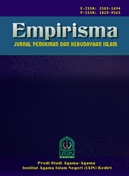Tradisi Anderenat Dalam Ekologi Budaya: Dinamika Interaksi Manusia Dan Lingkungan
DOI:
https://doi.org/10.30762/empirisma.v34i1.2876Keywords:
Anderenat Tradition, Cultural Ecology, Environmental AdaptationAbstract
This article aims to explore the Anderenat tradition on Gili Iyang Island through the lens of cultural ecology, with the objective of analyzing how local cultural practices function as mechanisms for environmental adaptation and conservation. Employing a qualitative descriptive method and an interpretive framework grounded in cultural ecology theory, the study investigates the embedded values and ecological functions within the Anderenat tradition, particularly in relation to how communities interact with and respond to their natural environment. The findings reveal that Anderenat is not merely a religious or ceremonial activity, but a complex ecological practice that embodies local wisdom transmitted through generations. It integrates spiritual beliefs, social rituals, and environmental actions—such as collective prayers, communal gatherings, and the symbolic planting of coconut trees—as strategic responses to ecological challenges like irregular rainfall and soil infertility. These practices not only reinforce communal solidarity but also cultivate ecological awareness and responsibility among community members. Moreover, the tradition fosters a sense of stewardship over natural resources, contributing to the long-term sustainability of the island’s fragile ecosystem. Theoretically, this study contributes to the discourse on environmental anthropology and cultural ecology by demonstrating how indigenous knowledge systems serve as functional and adaptive responses to environmental change. It suggests that traditions like Anderenat can serve as culturally grounded models for integrating local wisdom with modern scientific approaches in the development of inclusive and sustainable environmental policies
Downloads
References
Auerbach, Carl, and Louise B. Silverstein. Qualitative Data: An Introduction to Coding and Analysis. NYU Press, 2003.
Creswell, John W., William E. Hanson, Vicki L. Clark Plano, and Alejandro Morales. “Qualitative Research Designs: Selection and Implementation.” The Counseling Psychologist 35, no. 2 (March 1, 2007): 236–64. https://doi.org/10.1177/0011000006287390.
Dirdjosanjoto, Pradjarta. Memelihara Umat ; Kiai Pesantren-Kiai Langgar di Jawa. Lkis Pelangi Aksara, 1997.
“Ekologi Budaya - Menghubungkan Lingkungan Dan Manusia.” Accessed January 7, 2025. https://id.eferrit.com/ekologi-budaya-menghubungkan-lingkungan-dan-manusia/.
Encep Hidayat. Ekospiritual Dalam Pandangan Al-Quran. Jakarta: Publica Indonesia Utama, 2023.
Ezzy, Douglas. Qualitative Analysis. London: Routledge, 2013. https://doi.org/10.4324/9781315015484.
Fauzi, Muhammad Latif. “TRADITIONAL ISLAM IN JAVANESE SOCIETY: The Roles of Kyai and Pesantren in Preserving Islamic Tradition and Negotiating Modernity.” JOURNAL OF INDONESIAN ISLAM 6, no. 1 (June 1, 2012): 125–44. https://doi.org/10.15642/JIIS.2012.6.1.125-144.
Febrianto, Adri. Antropologi Ekologi: Suatu Pengantar. Prenada Media, 2016.
Hilmy, Ayu Nur Izzati, Susilo Kusdiwanggo, and Yusfan Adeputera Yusran. “KONSEP LIMINALITAS DALAM RITUAL ANDHERENAT.” Studi Budaya Nusantara 8, no. 1 (June 27, 2024): 43–58. https://doi.org/10.21776/ub.sbn.2024.008.01.03.
Holling, C. S. “Understanding the Complexity of Economic, Ecological, and Social Systems.” Ecosystems 4, no. 5 (2001): 390–405.
Hosinatun. “CA’BACA’AN DALAM TRADISI KEAGAMAAN MASYARAKAT MADURA DI PULAU GILIYANG, DUNGKEK, SUMENEP.” UIN SUNAN KALIJAGA YOGYAKARTA, 2024.
Izzuddin, Muchammad Ghozi, and Inayah Ilahiyah. “Tata Kelola Kowisata Berbasis Ergonomi Dan Kearifan Lokal Di Wisata Pulau Oksigen Gili Iyang.” Jurnal Ilmiah Pariwisata 27, no. 3 (November 15, 2022): 241–52. https://doi.org/10.30647/jip.v27i3.1552.
Julian Haynes Steward. Theory of Culture Change: The Methodology of Multilinear Evolution. University of Illinois Press, 1955. http://archive.org/details/theoryofculturec0000juli.
Kristiawan, Nana. “Pola Adaptasi Ekologi Budaya Tiga Komunitas di Jambi.” BHUMI: Jurnal Agraria dan Pertanahan 3, no. 2 (August 19, 2018): 189. https://doi.org/10.31292/jb.v3i2.124.
Mahrumo. Wawancara, Desember 2024.
Mahsyar, Rizal, Akhmad Tabrani, and Ari Ambarwati. “Ekologi Budaya Dalam Sastra Bahari Iko-Iko Masyarakat Bajo Di Kepulauan Sapeken.” NOSI 9, no. 2 (July 30, 2021). https://jim.unisma.ac.id/index.php/NOSI/article/view/12456.
Moran, Emilio F. People and Nature: An Introduction to Human Ecological Relations. Malden, Mass.: Wiley-Blackwell, 2006.
Muhammad Syariful Anam, Wina Yulianti, Sari Nur Safitri, Siti Nur Qolifah, and Rina Rosia. “KONSERVASI SUMBER DAYA ALAM DALAM PERSPEKTIF ISLAM.” Al-Madaris 2, no. 1 (2021).
Munir, Moh Sirojul, and Hoirul Anwar. “Mapping Quranic Exegesis in West Java: Influential Figures and Linguistic Insights.” Al-Karim: International Journal of Quranic and Islamic Studies 2, no. 1 (March 31, 2024): 51–72. https://doi.org/10.33367/al-karim.v2i1.4708.
Musleh, Moh. “Tata Kelola Wisata Pulau Gili Iyang: Perspektif Community Based Tourism.” Journal of Contemporary Public Administration (JCPA) 3, no. 1 (May 26, 2023): 42–50. https://doi.org/10.22225/jcpa.3.1.2023.42-50.
NORSALAM, AS’AD. “Representasi Nilai Budaya Andherenat Pada Masyarakat Gili Iyang Kabupaten Sumenep.” Diploma, INSTITUT AGAMA ISLAM NEGERI MADURA, 2021. http://etheses.iainmadura.ac.id/2227/.
Nugrahani, Farida. Metode Penelitian Kualitatif Dalam Penelitian Pendidikan Bahasa. Publisher, 2014. https://eprints.itn.ac.id/13583/.
Öhlmann, Philipp, and Ignatius Swart. “Religion and Environment,” December 22, 2022. https://doi.org/10.1163/15743012-bja10044.
Parto, Hilarion Gerri, F. X. Eko Armada Riyanto, and Mathias Jebaru Adon. “KESEIMBANGAN ALAM DAN MANUSIA: MENYIBAK NILAI-NILAI EKOLOGIS BUDAYA SUKU DAYAK KRIO BERDASARKAN PERSPEKTIF EKOLOGI THOMAS BERRY.” Jurnal BATAVIA 1, no. 03 (May 29, 2024): 145–58. https://journal.zhatainstitut.org/index.php/batavia/article/view/55.
Pongsibanne, Lebba Kadorre. Islam dan budaya lokal: Kajian Antropologi Agama, 2017. https://repository.uinjkt.ac.id/dspace/handle/123456789/43069.
Rachma, Alviani. “Modernizing the Tradition: Mengaji among Children of Urban Muslim Families in Indonesia.” IBDA` : Jurnal Kajian Islam Dan Budaya 21, no. 1 (April 1, 2023): 109–24. https://doi.org/10.24090/ibda.v21i1.6921.
“Refleksi Ekologi Budaya Masyarakat Bima Dompu Dalam Novel La Hami Karya Marah Rusli : Perspektif Julian Steward | Firdaus | Jurnal Ilmiah Mandala Education.” Accessed January 7, 2025. https://ejournal.mandalanursa.org/index.php/JIME/article/view/3579/2760.
Sadowski, Ryszard F., and Jacek Tomczyk. A holistic approach to environment conservation. Warszawa: Wydawn. Uniwersytetu Kardynała Stefana Wyszyńskiego, 2008.
Saharuddin, Munawir, and Tobroni Tobroni. “Model Penelitian Pendidikan Agama Islam Berbasis Integrasi-Interkoneksi : Analisis Pendekatan Pohon Ilmu, Jaring Laba-Laba, Dan Twin Tower.” Karakter : Jurnal Riset Ilmu Pendidikan Islam 1, no. 4 (November 14, 2024): 169–82. https://doi.org/10.61132/karakter.v1i4.203.
Sugiyono PD. Metode Penelitian Kuantitatif, Kualitatif, Dan R&D. Bandung: Alfabeta, 2010.
Sulaeman, Mubaidi. “Maqasid Al Syari’ah; Cara Islam Menghadapi Pandemi Covid 19.” Tribakti: Jurnal Pemikiran Keislaman 32, no. 2 (July 26, 2021): 263–82. https://doi.org/10.33367/tribakti.v32i2.1582.
Utami Rianti. “Rencana Pengembangan Pulau Giliyang Dalam Sektor Pariwisata.” Institut Teknologi Sepuluh November, 2014.
Zeng, Chuanhui. “Marxist View on the Religious Ecological Culture: A Review of the Western Studies in Religion and Environment and Their Discourses.” HTS : Theological Studies 78, no. 5 (n.d.): 9244. https://doi.org/10.4102/hts.v79i5.9244.
Zimmerer, Karl S. “Cultural Ecology: At the Interface with Political Ecology - the New Geographies of Environmental Conservation and Globalization.” Progress in Human Geography 30, no. 1 (February 1, 2006): 63–78. https://doi.org/10.1191/0309132506ph591pr.
Downloads
Published
How to Cite
Issue
Section
License
Copyright (c) 2025 Moh. Syaiful Bahri, Muhammad Ghufron

This work is licensed under a Creative Commons Attribution-NonCommercial-ShareAlike 4.0 International License.














 This work is licensed under a
This work is licensed under a 








